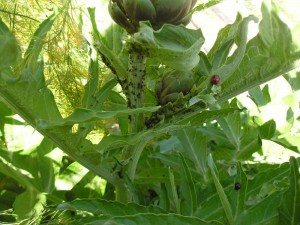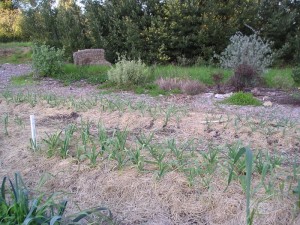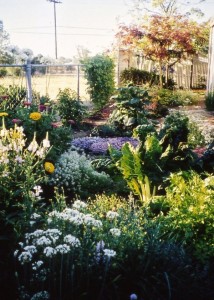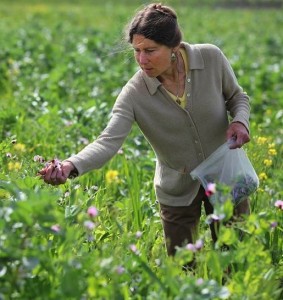The first time I saw Wendy Krupnick was at an Ecofarm conference three years ago – just after I moved to Sonoma County to manage the farm at Petaluma Bounty. I was chatting with the (amazing) staff at the Center for Agroecoloy and Sustainable Food Systems at UCSC, my alma-matter in farming education, and someone pointed out a braided, darting figure as she passed quickly through the room with bags and clipboards and posters (really quickly – she meant business!). I was told that I had to connect with Wendy, and that she had once gone through the same Santa Cruz apprenticeship program and was now an integral part of the Sonoma County agricultural education landscape.
For those of you who somehow aren’t yet familiar with the website Wendy contributes to– www.igrowsonoma.com – check it out immediately. It’s where I’ve learned the where, what and how about farming in our particular climate here in the North Bay – and then some.
So, this week on the blog, we’re excited to chat with Wendy about all aspects of her experience as a gardener, farmer, and teacher in Sonoma County.
Lennie Larkin: So Wendy, just how did you did you come to a career in agricultural advocacy and education?
Wendy Krupnick: My work has always centered on health – healthy food, and a healthy environment. The advocacy comes from my family, which was very involved with community and progressive issues. The teaching started when I began working for Shepherd’s Garden Seed company. One of my main responsibilities there was to work with home gardeners and answer any questions they had – we really encouraged customers to call and write with gardening questions. I was also the person responsible for variety trials – this gave me opportunity to learn how to grow things myself, and then know how to respond to questions. As the company grew, I began to teach other staff and give regular tours through the gardens. I’ve also worked on many farms throughout the years in different capacities, and have taught many interns and apprentices through hands-on farm work.
Has the focus of your work shifted over the years?
Well, these days, I have many volunteer commitments, including CAFF (Community Alliance with Family Farmers), the Food System Alliance, iGrow and others, and I’m a part time instructor at SRJC in sustainable agriculture. I’ve been with this program for 16 years. At first I was on the staff coordinating the garden, and then I began teaching a class or two. Now I teach short courses fairly regularly. In addition to this, I have a few regular home gardening clients, and many clients that I do tree pruning work for.
I’d say my career has shifted to be increasingly less hands on and more teaching-oriented. Leaving the staff at Shone Farm was really hard for me – it was the first time in adult life that I wasn’t directly connected with a farm. I’ve got a nice garden now, but it’s small. It’s so different from being on a farm, where the work is never done.
Another big shift in my work has been my growing focus on fruit trees and other perennials over the past fifteen years or so. I managed the acre and a half of fruit trees at Shone, and I worked on a fruit orchard back in the days after being at the seed company. Working on the orchard was really my chance to ‘learn by doing’ – which is the best way to learn the skills of fruit tree care.
I find orchard work to be such a nice change of pace from annual crop production.
Oh definitely. It really takes a hands-on, year-after-year relationship to learn trees. With pruning and dormant pruning, I find it to be like sculpting with light and wood. You’re managing the space between the trees, and aesthetics count!
Let’s talk about your work with home gardeners in our area. What are some of the most common questions asked by home gardeners?
I’d say the first would be ‘How much or how often should I water’?
And do you find that folks at home are usually watering too much or too little?
Both! I find that when people are new to gardening they tend to want to water with their eyes on the surface. They don’t dig down in their soil, so I always encourage people to get in there. New gardeners may be afraid to damage plants, but it’s important to find out what’s going on under the surface.
Watering habits is a hard issue to figure out. Especially this year and recently with the drought, people are rightfully concerned with how to save water. I do see a lot of stressed plants and trees around town – it’s a tricky balance. But there’s a lot people can do – I always encourage everyone to get going with a grey water system for the garden.
What other questions are at the top of people’s minds?
I’d say the aphid question is always at the top, and the answer is actually kind of complicated. I usually start by telling people that it’s not always a huge problem depending on what time of year and what plants we’re talking about. It can be a symptom of a stressed plant, or a plant that is trying to be grown during the wrong season (like broccoli growing in the hot summer). Folks can begin by just brushing them off or squirting a little Dr. Bronner’s solution on the plant. The water hose method isn’t actually the best, I find that the kind of pressure you need to use can in fact just damage the plants.

But for a more comprehensive, long-term approach, gardeners need to look to their soil health and make sure their plants are not stressed. It’s important to create a complete garden ecosystem, to grow plants that attract beneficial insects, and most of all, to observe and monitor their gardens.
One big line of questioning surrounds soil fertility, especially with people growing in raised beds. It’s tricky because we’re always telling people to add organic matter, which is really important, but I also tell them that adding a mineral component is important as well.
And what’s the easiest source of these minerals?
Well, ground soil. If at all possible, start with the soil you have in your garden or you can find outside somewhere, and then add products to that if need be. It may be challenging and will take a few years to build a rich soil, but will pay off in the long run. Additionally, a lot of people seem to have trouble understanding the difference between all the different bought-in products: compost vs. soil vs. amendments vs. mulch, so it’s worth researching the ingredients and components of the different products that you buy and what they will do for your soil. Ask questions at your local gardening center if you’re unsure.
What crops have you seen to be most favorable to our climate here in Sonoma County? Are there any crops you have continually seen people try to grow here, when in fact they should just give up or move?
Well, you can really grow pretty much anything here. I do see citrus struggling a lot. The last two years or so they have done pretty well with this heat. But citrus needs steady warmth, and can’t handle these sudden plummets in temperature in our winters here. They also need consistent watering. I’d say that unless you’re in a freeze-free environment, they are one of the more challenging crops to grow.
I feel that all the cool season crops are underrepresented. A lot of people just want to grow the popular summer crops – tomatoes and basil and cucumbers and the like.
What cool crops would you recommend, and when should they be started?
Cabbage and beets are so easy to grow – I would love to see more people growing these at home. They’re also such great foods to have in the kitchen – think of how versatile cabbage is!
There are a few time windows for starting cabbage. In general, if started from seed, these crops can be started from late February through late March. But for early, fast-growing cabbage, August first through mid-September is a fine time to start them. And again in July through August, late-season cabbage can be started.
Speaking of cool season crops, can you shed some advice on spring plantings? Am I the only one who has trouble timing my spring crops? Before I know it, summer always comes along too quickly! Peas, for example. I have horrible luck with peas.
Ha, no you’re not the only one.
With the right mix of attention to soil health, and enough water, you can extend the life of some of your cool season crops into the hot summer. Straw mulch also helps a lot, especially if we get a heat spell in May and June, as well as having a good supply of organic material deep down in the soil. Deep watering is also key.

What are you favorite Sonoma County native plants?
I’m a huge lover of native plants. I promote growing them every chance I get. I like to suggest that an ideal garden is made up of a small contained patch of edible plants, and the rest is native plants! I love Salvias, largest genus of plants in the mint family. So many of them are both cold hearty AND heat tolerant.
I also have a love of natives that remind me of the chaparral where I grew up – the smell of Ceanothus in the spring gets me every time. Coffeeberry, Toyon – Toyon! My mother would bring red Toyon berries into the house for the holidays when I was a kid, and I’ve loved them ever since.
And what do you suggest gardeners plant at home in order to attract beneficial insects?
Well when I moved into my current gardening space, one of the first things I did was plant alyssum and yarrow. They naturalize quickly, they’re tough, and they’re great for attracting beneficial insects. They may spread like crazy but in my mind, that’s OK.

Goldenrod, both the native and the cultivars, are great. Anything in the umbel family is great – parsley, dill, cilantro, fennel – just let them complete their life cycle and go to flower. Parsley has naturalized in my garden and I just love it (editor’s note: this refers to a plant that adapts to a new location as if it were a native).
And what about the best drought gardening advice for local gardeners?
I would suggest that people focus on developing drought-tolerant soil rather than looking for the magic bullet in terms of what exactly to plant. Sure, there are some plants that really do require more water than others – fresh beans being an example – but for the most part, the soil is the answer. You want to have soil that is deeply loosened and rich in good, organic material. This will allow your soil to act as a sponge and hold moisture. There are also a few good practices that can help the cause – such as not planting too close together and mulching. This is also where I’ll mention gray water systems again. People tend to be a little afraid and think that the installation is going to be expensive and difficult, but it doesn’t have to be.
What resources would you suggest for people looking to further their gardening knowledge?
We have so many resources starting with – iGrowsonoma.org, blogs like yours, our Master Gardener programs. Master Gardeners hold workshops at the library and are at most farmers markets and the county fair just waiting to answer questions. SRJC also has a great program, as does the Permaculture Skills Center, OAEC – and not to mention all the gardens out there to go visit. Ceres, Harvest for the Hungry, Sonoma Ecology Park, and all the community gardens in our area! What a great resource community gardens are. Where else can you see such a diversity of styles and plants. Everyone should visit some community gardens.
What a treat it was catching up with Wendy. For more information, please check out www.igrowsonoma.org. For information on native plants, please see the California Native Plant Society, and for information on gray water systems I really like this site.
And finally, let us know what questions YOU have out there! What gardening questions would you like to see on our next installment of Meet Your Local Farmer?








 Family
Family

